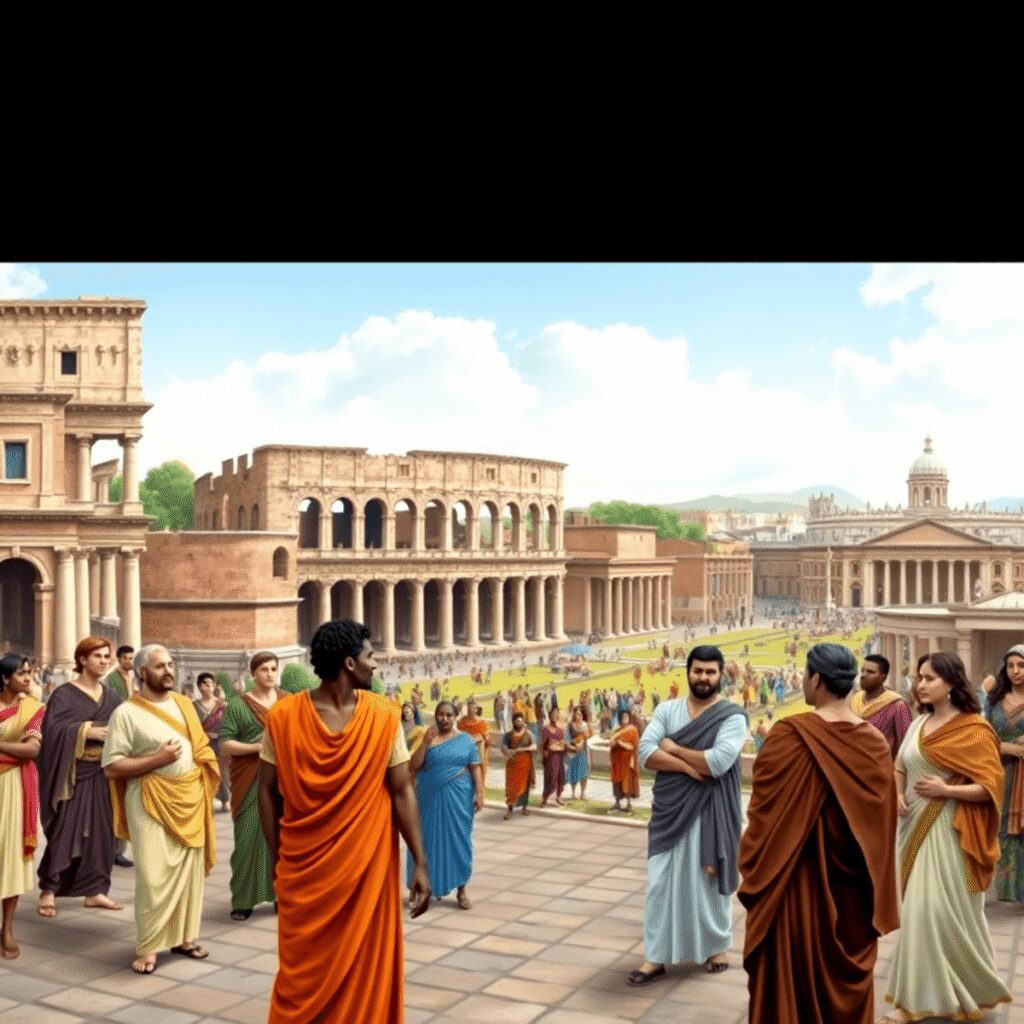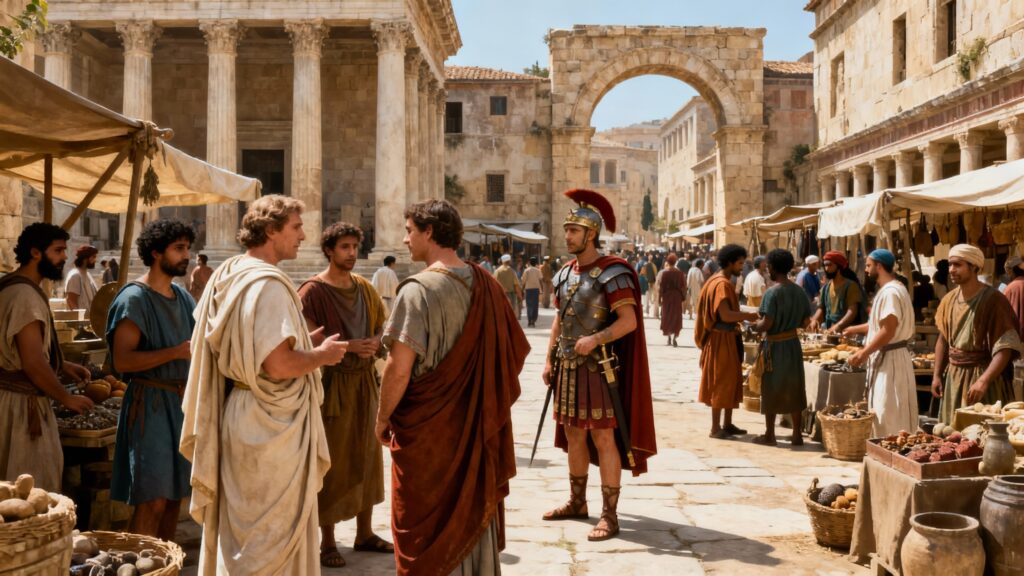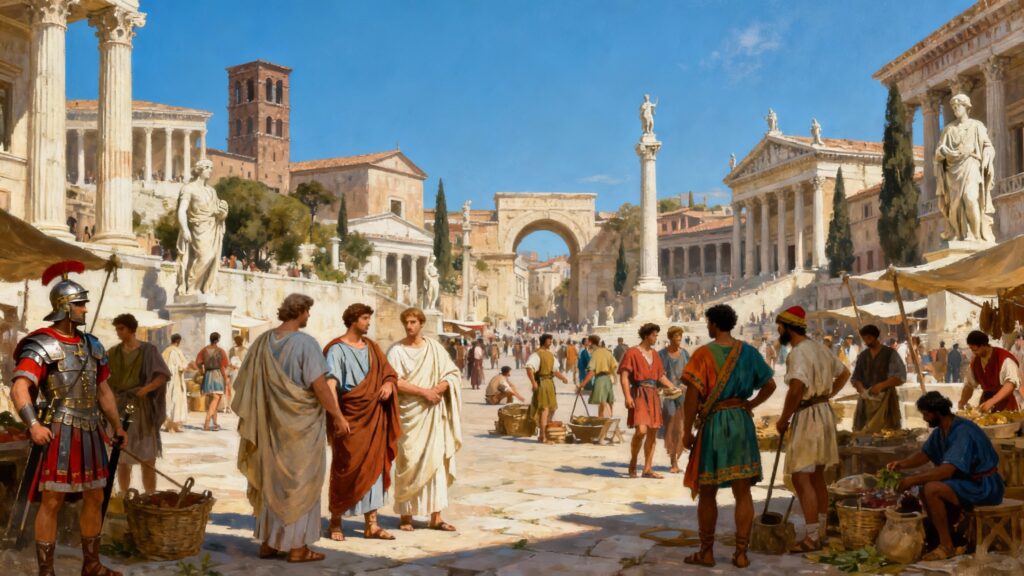Understanding legal rights for foreigners in Rome sheds light on the complexities of inclusion within one of history’s most influential empires.
The Roman Empire was a vast, multicultural entity encompassing diverse peoples from Europe, Africa, and Asia. This diversity created a complex social fabric where legal status deeply affected daily life, privileges, and opportunities.
The concept of ancient Rome citizenship played a pivotal role in defining who belonged and who remained outside full political and legal protection. Foreigners occupied various positions within Roman society, facing different levels of acceptance and restriction. Exploring how the empire managed these distinctions reveals much about Roman values, governance, and social control.
This article examines the Roman Empire inclusivity regarding foreigners—its limits, its practical approaches, and its legacy influencing modern ideas of citizenship and rights.
In addition to legal aspects, the cultural richness of ancient Rome also played a significant role in shaping the experiences of foreigners. The rituals and sacrifices practiced by Romans established a deep connection with their gods, reflecting their religious beliefs which were influenced by earlier cultures like the Greeks and Etruscans.
Furthermore, the masterpieces of Roman art serve as a testament to the empire’s vast reach and its ability to assimilate and innovate. This artistic tradition not only reflects the aesthetic values of its time but also the social, political, and cultural dynamics that shaped the Roman world.
Economically, the trade and economy in Ancient Rome were foundational to its vast empire. Understanding these intricate systems reveals the significance of economic practices that shaped one of history’s most powerful civilizations.
Lastly, it’s important to note that the Roman military was not merely a collection of soldiers; it was a well-oiled apparatus that combined discipline, strategy, and innovation. At its peak, the Roman army was a reflection of the empire itself—vast, diverse, and intricately structured.
The Structure of Legal Status in Ancient Rome
Roman citizenship was the highest legal and political status in the empire. It gave people exclusive rights such as voting, holding public office, being protected by Roman courts, and owning property without restrictions. However, this status was not given to everyone but only to a specific group of people, making a clear distinction between citizens and non-citizens.
Categories of Non-Citizens
Non-citizens were divided into several groups, each with different levels of legal recognition and limitations:
- Latini: Individuals from Latin communities who held Latin rights (ius Latii). Their privileges were limited compared to full citizens but included rights such as conducting business and marrying legally recognized spouses. They occupied an intermediate legal position.
- Socii: Allied states bound to Rome by treaties. Members of socii communities were not citizens but enjoyed certain protections and obligations under Roman law. Their legal standing depended on specific agreements with Rome, often involving military support.
- Peregrini: Foreigners without Roman citizenship residing within the empire. Peregrini had no political rights and limited legal protections. They were subject to local laws but also fell under aspects of Roman law, particularly ius gentium, which regulated commerce and interactions between different peoples.
Balancing Integration with Control
These classifications created a hierarchy that balanced integration with control. While all resided within Roman jurisdiction, only citizens accessed full civic participation and legal security. Non-citizen statuses reflected Rome’s pragmatic approach to managing a diverse empire composed of multiple ethnicities and cultures.

Roman Citizenship: Privileges and Acquisition
Roman citizenship was the cornerstone of legal identity in the empire, offering a suite of rights and privileges unavailable to non-citizens. Key Roman citizenship rights included:
- Voting in assemblies, allowing participation in political life.
- Eligibility for public office and military command.
- Legal protections, such as the right to a trial and immunity from certain punishments like crucifixion.
- Property ownership rights, including the ability to legally inherit and transfer wealth.
- Access to marriage under Roman law (conubium) which affected family status and legitimacy.
The acquisition of citizenship followed several avenues:
- By birth – children born to citizen parents automatically received citizenship.
- Public service – serving in the Roman military or civil administration could grant citizenship, especially for non-citizen allies demonstrating loyalty.
- Manumission – freed slaves gained limited citizenship rights, often lesser than those born free but still significant.
A transformative moment came with the Edict of Caracalla in AD 212, which extended full Roman citizenship to nearly all free inhabitants of the empire. This imperial decree aimed to unify diverse populations under a common legal framework and expand tax revenues linked to citizen status.
Citizenship was more than a legal label; it was a gateway to social mobility, political influence, and economic stability within Rome’s vast territories. The selective nature of citizenship acquisition reflected Rome’s balancing act between inclusion and maintaining elite control.
Non-Citizen Groups and Their Legal Limitations
The population of the Roman Empire included various groups besides full citizens, each with its own legal status and restrictions.
1. Latini Rights
The Latini were inhabitants of Latin towns with partial rights known as ius Latii. Their privileges were more limited than those of full Roman citizens. They could conduct business and marry under Roman law but lacked political rights such as voting or holding office. The status served as a middle ground between citizenship and complete foreignness.
2. Socii Allies
The socii were allied states bound to Rome through treaties, which played a crucial role in the Roman Republic’s expansion. They were not citizens but had obligations like military service. Socii maintained local autonomy but faced restrictions under Roman law, including the absence of voting rights in Roman assemblies. Their allegiance was crucial for Rome’s military expansion, yet legal inclusion remained limited.
3. Peregrini Foreigners
Peregrini refers to free foreigners living within the empire without Roman citizenship. They were subject to Roman law but often had restricted legal protections compared to citizens. Peregrini could own property and engage in contracts but lacked political participation and sometimes faced harsher penalties in courts.
4. Freed Slaves’ Legal Status
Freed slaves (liberti) occupied an intermediate social position. Though legally free, their rights did not fully match those born as citizens. Freedmen could work, marry, and own property but often remained socially dependent on former masters and faced limitations in public office eligibility.
These classifications reflect a layered system of inclusion, where legal rights for foreigners in Rome varied significantly depending on origin, status, and relationship to the city-state or empire.

Early Rome’s Approach to Foreigners: Inclusivity and Integration
Early Rome was known for being a welcoming place for various groups seeking refuge and opportunities. Its population included exiles, migrants, and religious minorities who found safety within the city’s walls. This openness was not accidental but rather a practical understanding of the advantages brought by diversity in workforce, skills, and cultural exchange.
Legal Support for Integration
The city’s laws encouraged integration, with one of the most significant measures being the Lex Canuleia (passed in 445 BC). This law allowed intermarriage between Roman citizens and members of other Latin communities, breaking down strict social barriers. Intermarriage played a crucial role in promoting social unity and forming political alliances, enabling immigrant families to become part of Roman society.
Informal Practices that Reinforced Inclusivity
Other informal practices also supported this inclusiveness:
- Providing shelter to individuals escaping persecution or conflict.
- Accepting skilled craftsmen and merchants whose presence invigorated the economy.
- Allowing religious minorities to practice their beliefs freely without severe punishment.
Impact on Population Dynamics
This approach helped early Rome maintain a vibrant population that contributed to its growth. Refugees and newcomers were often viewed less as dangers and more as potential assets to Rome’s expanding power. The policy of inclusion through legal reforms like Lex Canuleia demonstrates an early model of immigration that balanced social stability with opportunities for assimilation.
Shifting Attitudes: From Inclusion to Restriction
The expansion of the Roman Empire brought significant changes in attitudes toward foreigners, marked by the rise of nativist and xenophobic sentiments. As Rome absorbed diverse peoples, concerns about maintaining social order and cultural identity led to increasing suspicion of outsiders. This shift manifested in Roman immigration laws that aimed to control or limit the presence of certain foreign groups within the city and empire.
Key aspects include:
- Emergence of xenophobia in ancient Rome: Fear of cultural dilution and economic competition fueled hostility toward immigrants, especially those from outside Italy. Foreigners were often stereotyped as potential threats to Roman customs and stability.
- Legal measures targeting foreigners: Laws were enacted to regulate residency rights, restrict immigration flows, and authorize deportations. These measures reflected anxieties about overcrowding, moral decay, and political influence from alien populations.
- Deportations and expulsions: Certain foreign communities faced forced removal from Rome or Italian territories. Religious minorities and migrants from rival regions were common targets under these policies.
The tension between inclusion and exclusion during this period illustrates a pragmatic approach—Rome sought to protect its core identity while balancing the realities of an expanding multicultural empire. Legal restrictions on foreigners coexisted with mechanisms for integration, highlighting complex social dynamics shaped by fear as much as by acceptance.
Public Criticism and Mixed Feelings Toward Foreigners
Ancient Roman leaders expressed concerns about immigration laws that seemed harsh or unfair. Cicero, one of Rome’s most important speakers and politicians, spoke out against laws that aimed to limit or kick out foreigners. He often argued for fairness and compassion, warning against extreme actions that could harm social unity. Cicero’s viewpoint shows an understanding of the difficult situation Rome faced as it dealt with a varied population.
Mixed Views on Foreigners in Roman Society
Roman society had mixed feelings about outsiders, which can be seen in its founding stories. The tale of Aeneas, an immigrant hero who escaped Troy to eventually establish the Roman people, captures this contradictory emotion:
- Aeneas is celebrated as a noble immigrant ancestor.
- At the same time, his foreign origins emphasize conflicts between native Romans and newcomers.
These stories reveal a cultural acceptance combined with caution, influencing how legal rights for foreigners in Rome were determined both socially and politically.
Impact of Ambivalence on Policies and Public Opinion
This mixed feeling affected both policies and public perception. Foreigners could be viewed as crucial players in Rome’s greatness but also as possible dangers to its identity and stability. Recognizing this complex viewpoint helps clarify why Roman acceptance wasn’t absolute or completely dismissive but instead balanced between practical requirements and cultural tales.

Legal Protections for Foreigners Under Roman Law
Roman legal principles included specific provisions to manage interactions with foreigners, particularly through the concept of ius gentium — often translated as the “law of nations.” This was a set of rules that applied universally to all people under Roman influence, regardless of citizenship status. It functioned primarily in the context of commerce and legal transactions between Romans and non-Romans.
Key aspects of ius gentium
- Recognition of contracts and agreements made by foreigners, enabling trade and business dealings without requiring full Roman citizenship.
- Provision of legal remedies for disputes involving foreigners, offering protections under Roman courts even if full political rights were absent.
- Establishment of standards for fairness and good faith in commercial exchanges across different peoples within the empire.
Roman law protected foreigners by granting them certain civil safeguards such as property rights and access to justice. While they could not vote or hold office, foreigners enjoyed protection from arbitrary treatment when engaging in economic activities or legal matters. This pragmatic approach allowed Rome to regulate the diverse populations within its borders while encouraging economic integration.
Some legal mechanisms extended limited rights to peregrini (foreigners) so they could participate in trade or contracts safely. These protections helped maintain order and fostered cooperation between citizens and non-citizens alike. The ius gentium thus served as a flexible framework balancing Roman authority with inclusivity in everyday affairs involving foreigners.
The principles established during this era have left an enduring legacy on modern legal systems worldwide.
The Process of Romanization and Its Role in Inclusion
The Romanization process was a crucial way for the empire to bring different peoples together. Instead of giving full citizenship right away, Rome often used limited citizenship grants or specific legal rights for allied communities. These partial inclusions encouraged cooperation and loyalty while still keeping control over local populations.
Key elements of this approach included:
- Latin Rights (ius Latii): A form of limited citizenship offered to certain allied towns and individuals, allowing them some legal privileges like property ownership and commercial rights without full political participation.
- Municipal Citizenship: Some communities were incorporated as municipia, granting collective rights that increased over time depending on their relationship with Rome.
- Military Service: Serving in Roman auxiliary forces could lead to citizenship grants upon completion, blending military obligation with political assimilation.
The political motivations behind these measures aimed at maintaining stability in the empire by creating a system where loyalty was rewarded gradually. This approach helped reduce resistance from conquered peoples and made governance smoother. Partial inclusion also encouraged the adoption of Roman customs, language, and legal frameworks, fostering cultural assimilation without immediate disruption.
The gradual extension of rights reflected a practical balance between openness and control, using assimilation as a tool to unite different groups into the Roman state while still preserving distinctions based on origin and status.
Balancing Openness with Control: The Pragmatic Nature of Roman Inclusivity
Roman inclusivity was shaped by a pragmatic approach focused on managing a vast and diverse empire rather than embracing universal equality. The empire’s legal system granted rights strategically, balancing the benefits of integration with the necessity of maintaining control over its population.
Key features of this pragmatic inclusivity include:
- Conditional access to legal rights: Citizenship and its privileges were extended selectively. While the Edict of Caracalla significantly broadened citizenship, distinctions remained based on social class, origin, and loyalty.
- Social class distinctions shaped legal standing: Elite classes enjoyed full political participation, while lower classes—even if citizens—faced limitations. Non-citizens often held restricted or partial rights, reflecting their place within the social hierarchy.
- Empire population control through legal stratification: By creating tiers of rights—from full citizens to peregrini—the Roman state managed integration without dissolving essential boundaries that preserved Roman identity and authority. This structure allowed Rome to absorb new peoples while controlling potential threats from unrest or divided loyalties.
This nuanced system avoided blanket inclusion or exclusion. Instead, it fostered a flexible but controlled model where legal rights for foreigners in Rome adapted pragmatically to political needs and social realities. Such an approach ensured stability in an empire defined by its complex demographic makeup and competing interests.
However, political instability and weak leadership eventually undermined this stability, contributing significantly to the decline of the Western Roman Empire. This downfall was not merely the result of external invasions but rather a complex interplay of internal strife and ineffective governance.
In contrast to the political landscape, Roman sculpture evolved significantly over time, reflecting the cultural, political, and social dynamics of ancient Rome. This art form showcased a distinct focus on realism and the portrayal of power, serving not only as artistic expressions but also as instruments for political propaganda and religious devotion.
Moreover, the Roman Pantheon, a diverse collection of gods and goddesses worshipped in ancient Rome, reflects the values, beliefs, and customs that influenced the lives of its people. At the heart of this pantheon are important figures representing power, justice, and wisdom.
Such complexities are further explored in academic studies like this one on the pragmatic nature of Roman inclusivity, which delves deeper into how these dynamics played out in practice.
Conclusion
The inclusivity legacy Roman Empire left is complex yet foundational for modern legal systems. Roman frameworks established clear distinctions in foreigners legal status summary, balancing privileges and restrictions based on citizenship, origin, and social rank. This pragmatic approach influenced contemporary ideas about citizenship as both a right and a tool of political integration.
Key impacts include:
- The concept of legal rights tied to citizenship rather than mere residence.
- The use of partial inclusion—such as limited citizenship—to assimilate diverse populations.
- Recognition of international legal principles like ius gentium shaping relations with foreigners.
Roman law’s nuanced stance on inclusion reveals that Legal Rights for Foreigners in Rome: How Inclusive Was the Empire? cannot be answered simply. The empire was inclusive enough to absorb vast peoples but maintained controls that defined belonging and participation. This duality echoes in modern debates on immigration, citizenship, and multiculturalism—demonstrating the enduring influence of Rome’s legal legacy. Indeed, the influence of Roman society on Western civilization is profound, with their intricate social structures and innovative ideas laying the groundwork for many aspects of modern life.
FAQs (Frequently Asked Questions)
What were the different legal statuses for foreigners in Ancient Rome?
In Ancient Rome, foreigners were classified into several groups with varying legal standings including Latini, socii (allied states), and peregrini (foreigners without citizenship). Roman citizenship was a privileged status granting extensive rights, while non-citizen groups had limited legal protections and rights.
How could one acquire Roman citizenship during the Empire?
Roman citizenship could be acquired by birth, through public service, or by special grants such as the Edict of Caracalla in AD 212 which extended citizenship to all free inhabitants of the Empire. Citizenship conferred important privileges like voting, property ownership, and legal protections.
What legal rights did non-citizen groups like Latini and socii have in Rome?
Latini had limited rights compared to full citizens, while socii were allied states with a degree of autonomy but restricted legal status. Peregrini were foreigners without citizenship and faced significant limitations. Freed slaves occupied an intermediate position with some legal recognition but fewer rights than born citizens.
How did early Rome promote inclusivity and integration of foreigners?
Early Rome was known as a refuge for exiles, migrants, and religious minorities. Laws such as Lex Canuleia allowed intermarriage between Romans and foreigners, facilitating social integration and promoting inclusivity within the population.
What factors led to shifting attitudes towards foreigners from inclusion to restriction in Rome?
As the Roman Empire expanded, nativist and xenophobic sentiments grew leading to stricter immigration laws and deportations targeting certain foreign groups. Public criticism by figures like Cicero reflected societal ambivalence toward foreigners despite cultural myths celebrating immigrant origins.
How did Roman law protect foreigners despite their lack of full citizenship?
Roman law recognized the concept of ius gentium (law of nations) which governed relations with foreigners especially in commerce. This provided certain legal protections and commercial rights to non-citizens, reflecting a pragmatic approach balancing openness with control within the Empire.

